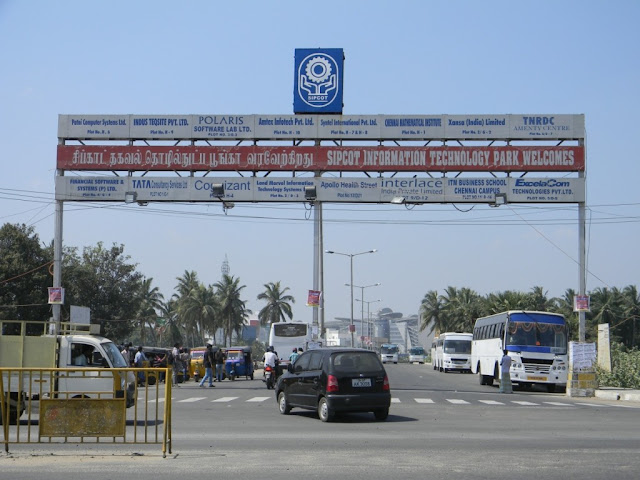 |
| © https://en.wikipedia.org/wiki/SIPCOT_IT_Park |
எதிர்காலத்தின் கதவுகளை தொழில்நுட்பச்சாவி கொண்டு திறந்து கொண்டிருக்கும் லட்சத்திற்கும் மேலான (அதில் 60 சதவிகிதத்திற்கும் மேல் இளைஞர்கள்) பணியாளர்களைக் கொண்டிருக்கும் ஒரு தகவல் தொழில்நுட்ப நிறுவனத்தில், ஒரு மேலாளர் புதிதாக தன் குழுவில் சேரும் பணியாளரின் சாதி குறித்து வெளிப்படையாக விசாரிக்கிறார். எவ்வளவு கேவலமான, அநாகரீகமான பிற்போக்குத்தனம் இது!!!
இந்திய தகவல் தொழில்நுட்ப நிறுவனங்களில் சாதி, உருவ அமைப்பு, சமயம், பாலினம், பாலின சார்பு, ஆகியவற்றின் அடிப்படையில் வேறுபடுத்தி நடத்துவது ஒன்றும் புதிதல்ல. ஐக்கிய அமெரிக்காவில் தலைமையகம் கொண்டு இந்தியாவில் கிளைகளை கொண்டுள்ள நிறுவனங்களும் இதற்கு விதிவிலக்கல்ல. தகவல் தொழில்நுட்ப சேவை நிறுவனங்கள் தங்கள் கொள்கைகளில் அனைத்துவிதமான பாகுபாடுகளுக்கும் எதிராகத்தான் இருக்கின்றன. நான் பணிபுரிந்த நிறுவனம் பாகுபாடுக்கு எதிரான தீவிரமான கொள்கைகளைக் கொண்டுள்ளதோடு அதை பற்றி புகாரளிக்கவும் பல்வேறு வழிமுறைகளையும் வகுத்துள்ளது. இருப்பினும் லட்சம் பேருக்கு மேல் உள்ள ஒரு நிறுவனத்தில் நடைமுறையில் அந்த கொள்கைகள் பின்பற்றப்படுகின்றனவா என முறையாக கண்காணிப்பதில்லை. பாதிக்கப்படும் பணியாளரும் பெரும்பாலும் புகாரளிக்கும் தைரியமோ அதற்கான வழிமுறைகள் பற்றிய அறிவோ இல்லாமல் தான் இருக்கிறார்.
தனியார் நிறுவனங்களில் வகுப்புவாரி இடஒதுக்கீடு தேவையில்லை என்பது எனது தற்போதைய நிலைப்பாடு. ஆனால் பணிக்கு தேர்வாகும் பணியாளர்கள் எந்த நிலையிலும் சாதிரீதியாக பாகுபடுத்தப்படாமலிருப்பதை உறுதி செய்யவேண்டும். ஒருகாலத்தில் அரசு பணிகளில் அதீதமாக இருந்த சாதிரீதியான பணி மறுப்பும், பணியின்போது பாகுபாடும் இன்றைய இடஒதுக்கீடு முறைக்கு முக்கிய காரணங்களில் ஒன்றென்பது நினைவிலிருக்கட்டும். நீங்கள் விதிமுறைகளின் மறைவிடங்களை பயன்படுத்தி உங்கள் இனத்தாருக்கு செய்யும் சலுகைகளின் தாக்கம் என்றைக்கு வெடித்துக் கிளம்புகிறதோ அன்றைக்கு தனியாரிலும் இடஒதுக்கீடு கட்டாயமாக்கப்படலாம்.
சாதிப்பகுபாட்டைச் சார்ந்த சலுகைகளைப்போலவே இடஒதுக்கீடும் குறிப்பிடத்தகுந்த அளவுக்கு சோம்பேறிகளையும் அறிவிலிகளையும் மேன்மைப்படுத்தி வைத்திருக்கிறது என்பது உண்மை தான். ஆனால் அதற்காக, சமூகநீதியானது 20% கூட நிலைநாட்டப்படாத இக்காலகட்டத்தில் இடஒதுக்கீடை நீக்கிவிடமுடியாது.
ஒரு பெருநிறுவனத்தில் மத்திய மற்றும் உயர்மத்திய மேலாண்மை வர்க்கம் பாதி அளவுக்கும் மேல் குறிப்பிட்ட சாதியினராகவே இருப்பதற்குப் பேர் தான் "diversity"யா? ஒரு நிறுவனத்தில் இருந்து இன்னொன்றுக்கு தாவிய பின் அங்கும் தனக்கு வேண்டியவர்களையும்,தன் இனத்தாரையும் கொஞ்சம் கொஞ்சமாக உள்ளே இழுத்துக்கொள்வதற்க்கு பேர் தான் "meritocracy" யா? இந்த முறைகேடுகளை உயர் மேலாண்மை வர்க்கம் கண்டும் காணாமல் இருப்பதற்கு பேர் தான் "transparency" யா?
ஆண்டு இறுதியில் பணிமதிப்பீடு செய்வதிலும், விசாவிற்கு பரிந்துரைப்பதிலும் மட்டுமின்றி பணியாளர்களை அங்கீகரிப்பதிலும் கூட திட்டமிட்டு பாகுபாட்டை செயல்படுத்தும் இந்த மேலாளர்களை நேர்மையான விசாரணைக்கு உட்படுத்தும் பொறுப்பு யாருக்கு உள்ளது?




